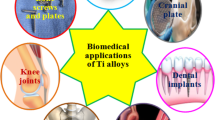Results are provided for a study of the effect of mechanical and ion-beam treatment on titanium alloys surface relief parameters. The possibility is demonstrated of changing component surface roughness over a wide range after comprehensive surface treatment including successive mechanical treatment and irradiation with powerful ion beams in order to improve adhesion properties that expands the range for application of titanium alloys, in particular in medicine. Surface modification and its treatment is a problem for titanium alloys since in view of physical properties titanium alloys exhibit very poor tribological properties and low adhesive strength.




Similar content being viewed by others
References
D. M. D. Ehrenfest, P. G. Coelho, B. S. Kang, et al., “Classification of osseointegrated implant surfaces: materials, chemistry and topography,” Trends in Biotechnology, 28, No. 4, 198–206 (2010).
X. S. Bauer, P. Schmuki, K. von der Mark, et al., “Engineering biocompatible implant surfaces. Part I: Materials and surfaces,” Progress in Materials Science, 58, No. 3, 261–326 (2013).
D. Duraccio, F. Mussano, and M. G. Faga, “Biomaterials for dental implants: current and future trends,” J. Materials Science, 50, No. 14, 4779–4812 (2015).
X. P. Zhu, M. K. Lei, and T. C. Ma, “Surface morphology of titanium irradiated by high-intensity pulsed ion beam,” Nuclear Instruments and Methods in Physics Research, Section B: Beam Interactions with Materials and Atoms, 211, No. 1, 69–79 (2003).
S. Hansson and M. Norton, “The relation between surface roughness and interfacial shear strength for bone-anchored implants. A mathematical model,” J. Biomechanics, 32, No. 8, 829–836 (1999).
V. A. Shulov, N. A. Nochovnaia, and G. E. Remnev, “The effect of crater creation on the fatigue strength and corrosion resistance of steels and titanium alloys irradiated by high-power pulsed ion beams,” Surface and Coatings Technology, 158, 488–493 (2002).
X. P. Zhu, H. Suematsu, W. Jiang, et al., “Pulsed-ion-beam nitriding and smoothing of titanium surface in a vacuum,” Appl. Phys. Lett., 87 (2005).
K. I. Yokoyama, T. Ichikawa, H. Murakami, et al., “Fracture mechanisms of retrieved titanium screw thread in dental implant,” Biomaterials, 23, No. 12, 2459–2465 (2002).
Author information
Authors and Affiliations
Corresponding author
Additional information
Translated from Metallurg, Vol. 62, No. 11, pp. 80–84, November, 2018.
Rights and permissions
About this article
Cite this article
Tarbokov, V.A., Pavlov, S.K., Remnev, G.E. et al. Titanium Alloy Surface Complex Modification. Metallurgist 62, 1187–1193 (2019). https://doi.org/10.1007/s11015-019-00772-4
Received:
Published:
Issue Date:
DOI: https://doi.org/10.1007/s11015-019-00772-4




